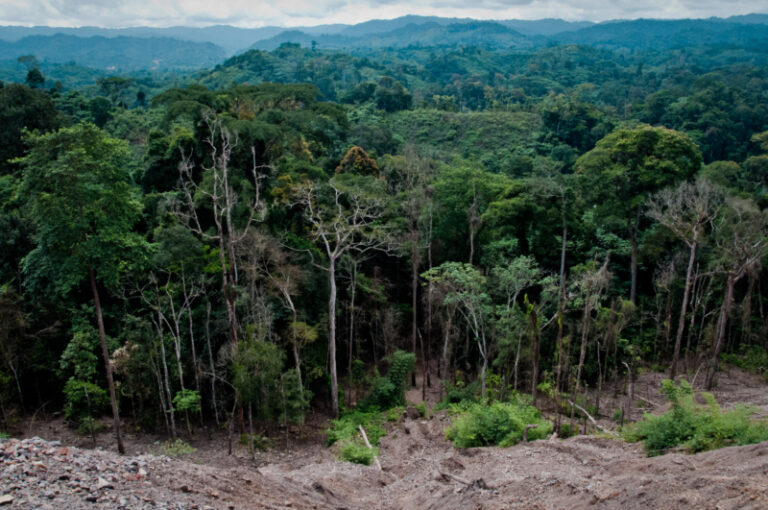What is the role of deforestation in climate change and how can 'Reducing Emissions from Deforestation and Degradation' (REDD+) help?

What is the scale of deforestation and its role in climate change?
Deforestation refers to the purposeful clearing or thinning of trees and forests. When deforestation occurs, much of the carbon stored by trees is released back into the atmosphere as carbon dioxide, which contributes to climate change.
In the last decade, the largest amounts of deforestation occurred across the humid tropics, mostly in Africa, followed by South America. The UN Food and Agriculture Organisation (FAO) estimates that around 420 million hectares of forest were lost between 1990 and 2020 (or 178 million hectares net, i.e. taking into account afforestation and the natural expansion of forests). The annual rate of deforestation has since slowed but was still 10 million hectares per year between 2015 and 2020. The most important driver of deforestation is the global demand for agricultural commodities: agribusinesses clear huge tracts of forest and use the land to plant high-value cash crops like palm oil and soya, and for cattle ranching.
Land use change, principally deforestation, contributes 12–20% of global greenhouse gas emissions. Forest degradation (changes that negatively affect a forest’s structure or function but that do not decrease its area), and the destruction of tropical peatlands, also contribute to these emissions. As a result of deforestation and degradation, some tropical forests now emit more carbon than they capture, turning them from a carbon ‘sink’ into a carbon source. For example, the south-eastern part of the Amazon Rainforest is now considered a net carbon source by scientists.
Where does ‘REDD+’ come in?
Scientists have recognised the value of protecting forests in tackling climate change. In response, policymakers have developed a family of policies – collectively known as ‘reducing emissions from deforestation and degradation’ (REDD) – to provide a financial incentive to governments, agribusinesses and communities to maintain and possibly increase, rather than reduce, forest cover. The plus in ‘REDD+’ refers to “the role of conservation, sustainable management of forests and enhancement of forest carbon stocks in developing countries”. Under REDD+, incentives for forest protection are offered to countries, communities and individual landowners in exchange for slowing deforestation, and carrying out activities that promote reforestation and sustainable forest management. Where local people are properly involved in the REDD+ process it may also help alleviate rural poverty. The principles of REDD+ were further reinforced in the Paris Agreement on climate change.
REDD+ policies operate through a variety of mechanisms, including those administered by the United Nations (UN-REDD) and the World Bank (the Forest Carbon Partnership Facility). REDD+ finance is also considered in the international climate change negotiations, remains a key component of international climate finance discussions, and is often channelled through the voluntary carbon markets and via activities implemented by for- and non-profit organisations.
How fair, effective and efficient is REDD+?
While experts have demonstrated how REDD+ has the potential to reduce CO2 emissions, it is not without its problems. For example, some question the fairness of a scheme that focuses on reducing emissions caused by some of the world’s poorest people while emissions continue to rise in richer countries. Some developing countries may be wary of foreign interference in their land use policies. Researchers also highlight operational concerns – such as the difficulty in monitoring and measuring deforestation rates, or attributing changes in deforestation to REDD+ finance. Variations in local circumstances and institutional capacities mean that not all countries that have tropical forests possess the capabilities to address these challenges.
How much REDD+ finance has been pledged?
Estimates of the global cost of REDD+ vary greatly, but at least US$15 billion would be needed annually to address tropical deforestation across the world. Current funding remains far off this mark: according to a 2020 review, between 2015 and 2019 an average of US$220 million a year of funding was approved. The Amazon Fund, with US$720 million of approved projects, remains the largest dedicated REDD+ fund.
Without sufficient finance, it can be difficult to protect forests, as alternative land uses (such as for palm oil) can offer more immediate and guaranteed cash returns. Consequently, many experts have called for a scaling up of commitments and finance flows, although some have argued that even if large-scale REDD+ finance does materialise it may still struggle to compete with other land uses – especially as and when commodity prices rise.
Whatever becomes of REDD+ in the future, experts agree it should focus first on areas that can most efficiently provide CO2 reductions (such as tropical peat swamp forests) while also offering the potential for biodiversity conservation and poverty alleviation.
This Explainer was updated in February 2023 by Charles Palmer, Natalie Pearson and Georgina Kyriacou. The original was reproduced from: What’s REDD and will it help tackle climate change?, a collaboration between the Grantham Research Institute and the Guardian, © The Guardian 2012, used under a Creative Commons No Derivative Works licence.

